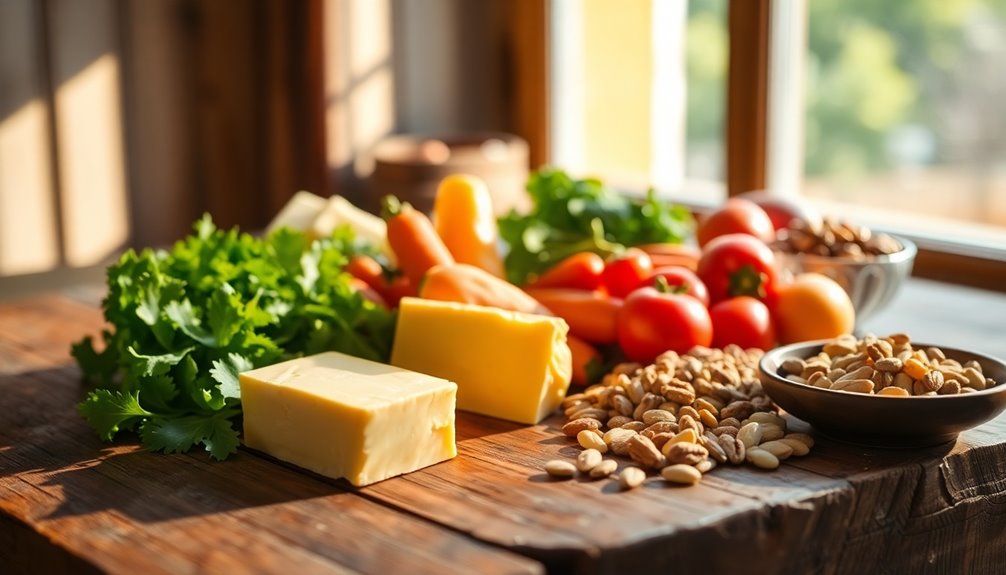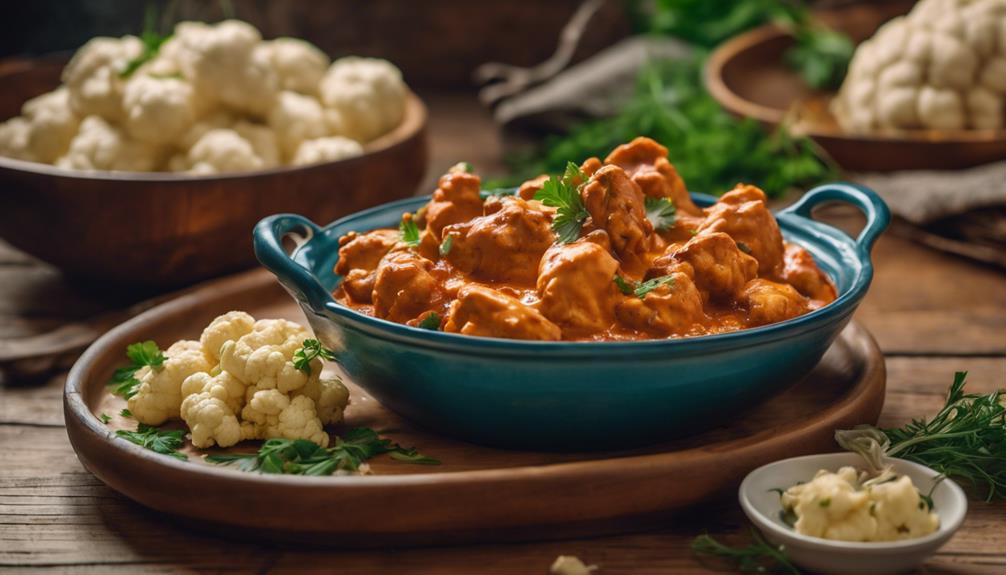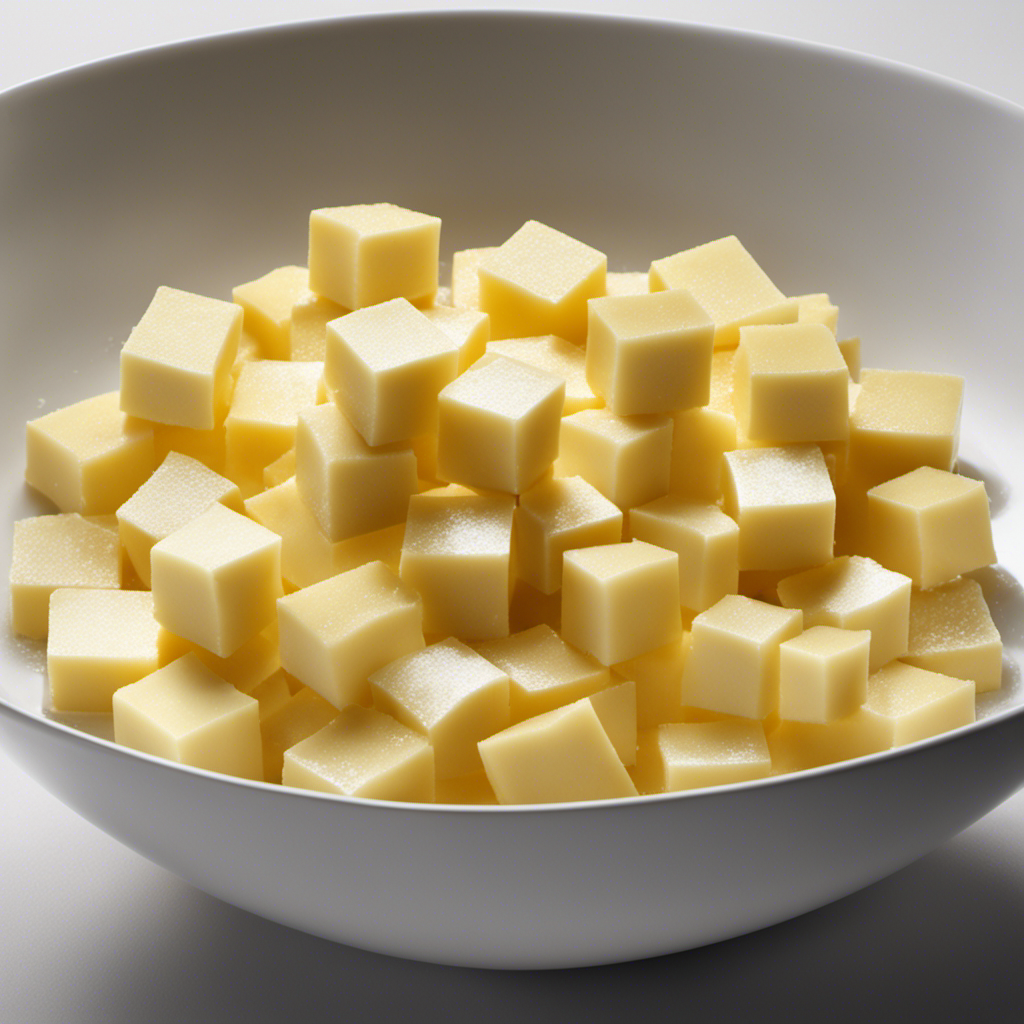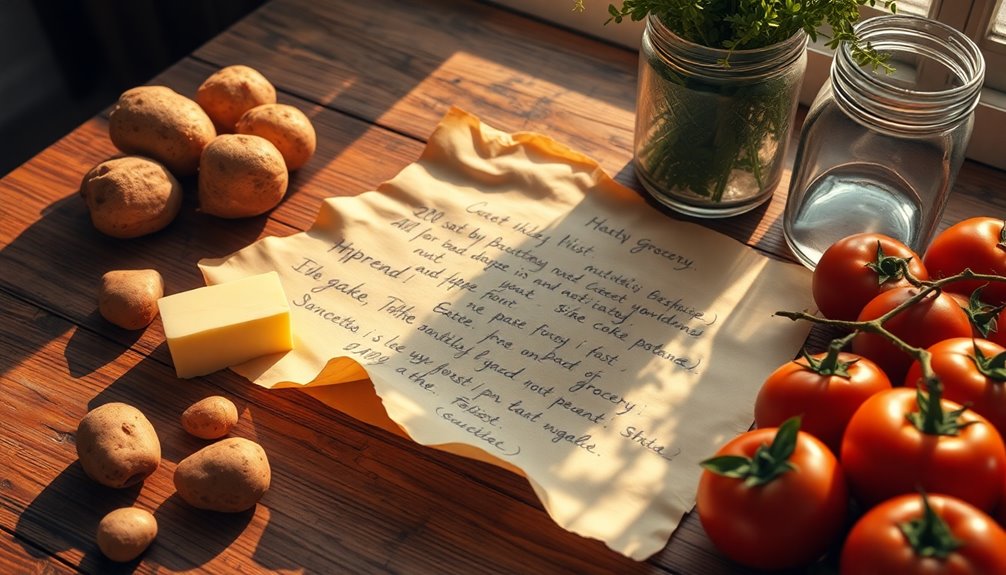Butter isn't strictly Paleo, but you can include it if you choose wisely. Opt for grass-fed butter, which has a better nutrient profile, but use it in moderation. Regular butter contains lactose and casein, which some people find hard to digest, so it doesn't fit perfectly within the Paleo framework. Instead, consider ghee as an excellent alternative; it's lactose-free and aligns more closely with Paleo principles. Remember, moderation and quality are key in any diet, including Paleo. If you're curious about other alternatives and tips, you'll find even more guidance ahead.
Key Takeaways
- Regular butter is not strictly Paleo due to lactose and casein, which can cause digestive issues for many individuals.
- Grass-fed butter is nutritionally superior but still doesn't meet strict Paleo standards, as it was not consumed by Paleolithic ancestors.
- Ghee is a Paleo-compatible alternative, being lactose and casein-free, and offers health benefits such as anti-inflammatory properties.
- Moderation is essential; use butter or ghee as flavor enhancers rather than primary fat sources to maintain dietary balance.
- Avoid processed alternatives like margarine, focusing on unprocessed options to adhere to Paleo principles and support health goals.
Understanding the Paleo Diet
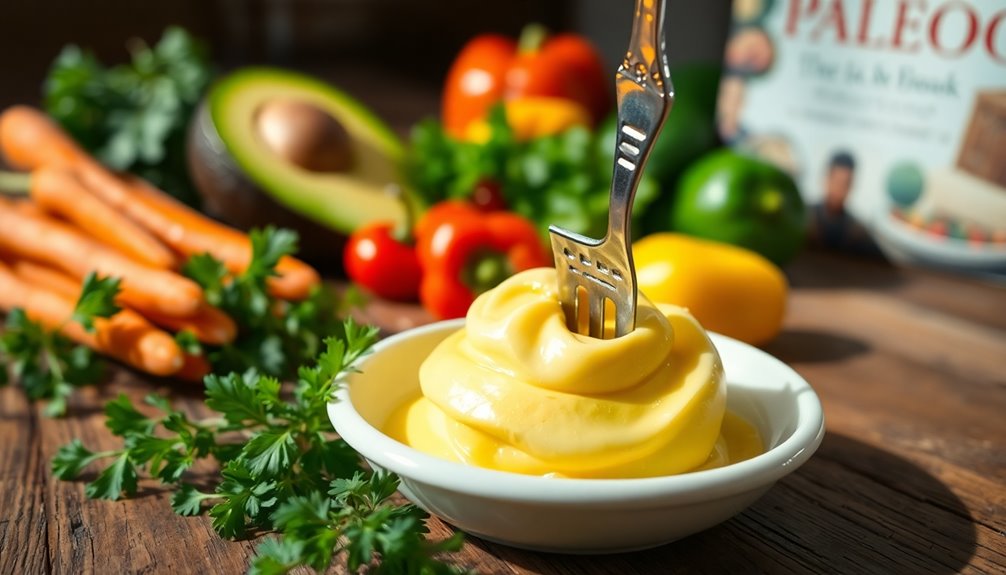
The Paleo diet primarily focuses on whole, unprocessed foods that mimic what our Paleolithic ancestors likely consumed. You'll find that it emphasizes lean meats, fish, fruits, vegetables, nuts, and seeds while avoiding highly processed and industrialized foods. The goal is to prioritize foods in their natural state, leading to a diet that excludes grains, legumes, and dairy products.
When you adopt this diet, you'll enjoy lean proteins from grass-fed animals, poultry, fish, and eggs, all rich in essential amino acids and micronutrients. Healthy fats are also key, sourced from nuts, seeds, avocados, and oils like olive, coconut, and avocado oil. You'll steer clear of trans fats and highly processed vegetable oils. An 85/15 split is suggested for flexibility, allowing for 85% adherence to Paleo foods and 15% personal choices.
Moreover, you'll benefit from a high intake of fruits and vegetables, which provide essential vitamins, minerals, fiber, and antioxidants. Leafy greens, root vegetables, and a variety of fruits are all encouraged. You can also use fresh or dried herbs to enhance flavors.
As for beverages, water and herbal tea are your go-tos, with coffee in moderation. By sticking to these guidelines, you're aligning your eating habits with those of our ancestors.
Dairy Products in Paleo
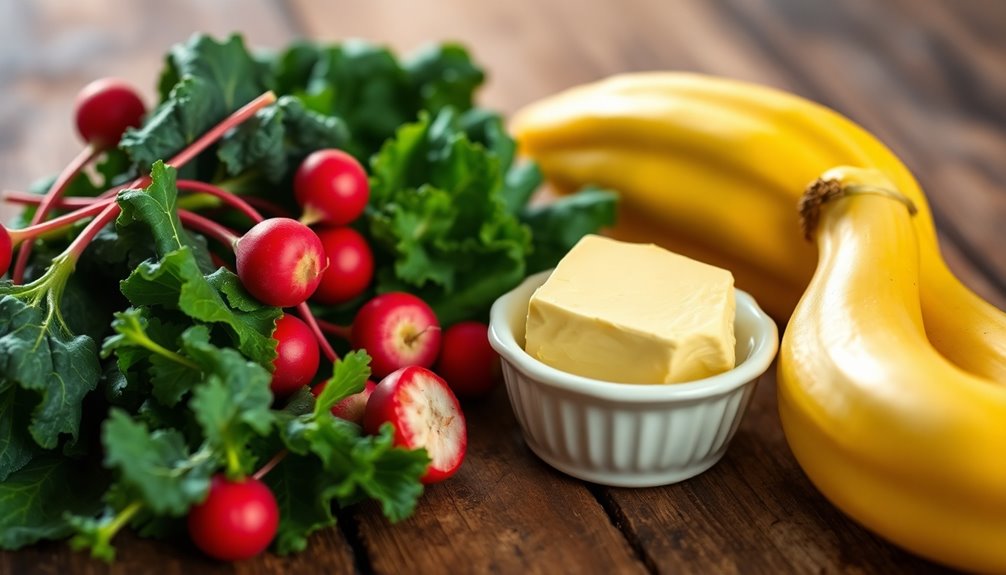
Dairy products are a contentious topic within the Paleo community, often sparking debate among enthusiasts. While some argue for their nutritional benefits, traditional Paleo guidelines exclude dairy due to its high lactose content and the fact that it wasn't consumed before modern agriculture.
With around 65% of the global population being lactose intolerant, it's clear that dairy isn't suitable for everyone. Additionally, the welfare of factory-farmed cattle raises ethical concerns, further supporting dairy's exclusion from the diet. Moderate dairy consumption has been linked to overall health benefits, which adds to the complexity of the debate.
Despite these reasons, dairy does offer vitamins and minerals, including calcium and protein. Some experts suggest that if early humans had encountered pregnant wild animals, they might've consumed dairy sporadically. However, this isn't a regular part of the caveman diet.
If you're considering dairy, start by eliminating all forms to test for sensitivities. Then, you can cautiously reintroduce high-quality options like ghee or grass-fed, fermented products.
Ultimately, the choice to include dairy in your Paleo journey should depend on your tolerance and personal health goals, keeping in mind that many opt for complete exclusion due to its non-Paleo classification.
Butter's Origin and Composition
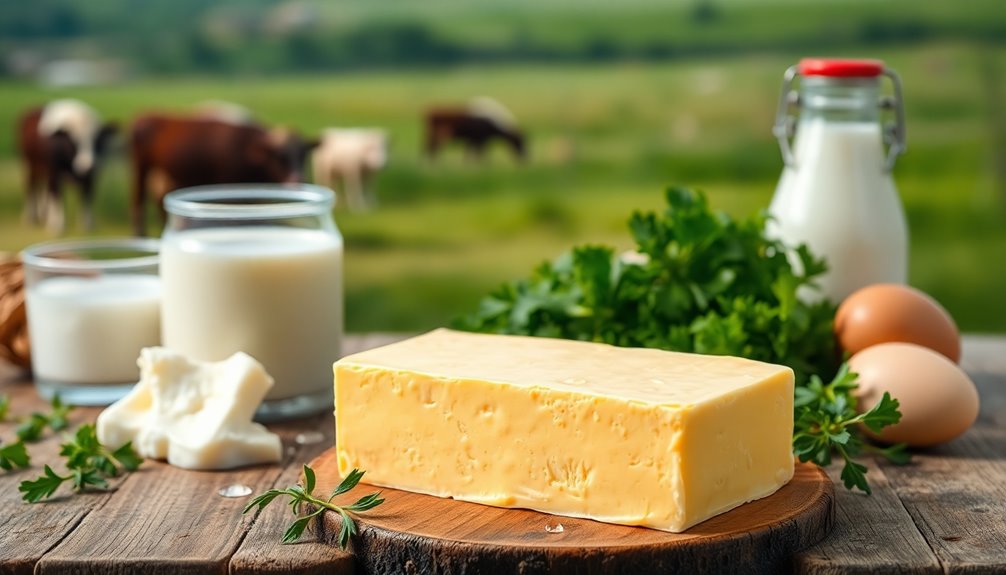
When considering the inclusion of certain fats in a Paleo diet, butter often comes into the discussion. Butter's history dates back around 4,500 years, with the earliest evidence of butter-making discovered on a limestone tablet from ancient Mesopotamia.
Initially, people made butter by agitating cream, which separated fat from watery substances, resulting in butter and buttermilk.
Legally, the term "butter" refers specifically to products derived from cow's milk or whey, adhering to strict guidelines. It must contain at least 80% fat, a maximum of 16% water, and no more than 2% lean dry residue, which includes lactose, protein, and minerals. If butter comes from other animals, it must specify the species.
Chemically, butter is primarily made up of triglycerides, which consist of a glycerol backbone and three fatty acid chains. The composition includes various fatty acids, such as palmitic and oleic acids, contributing to its solid state at room temperature. Additionally, butter has a long-standing history as a staple dairy product across various cultures, highlighting its significance in culinary practices.
Additionally, butter contains about 80-82% milk fat, 16-17% water, and 1-2% other milk solids, with its structure significantly affecting its melting characteristics and flavor profile.
Nutritional Profile of Butter
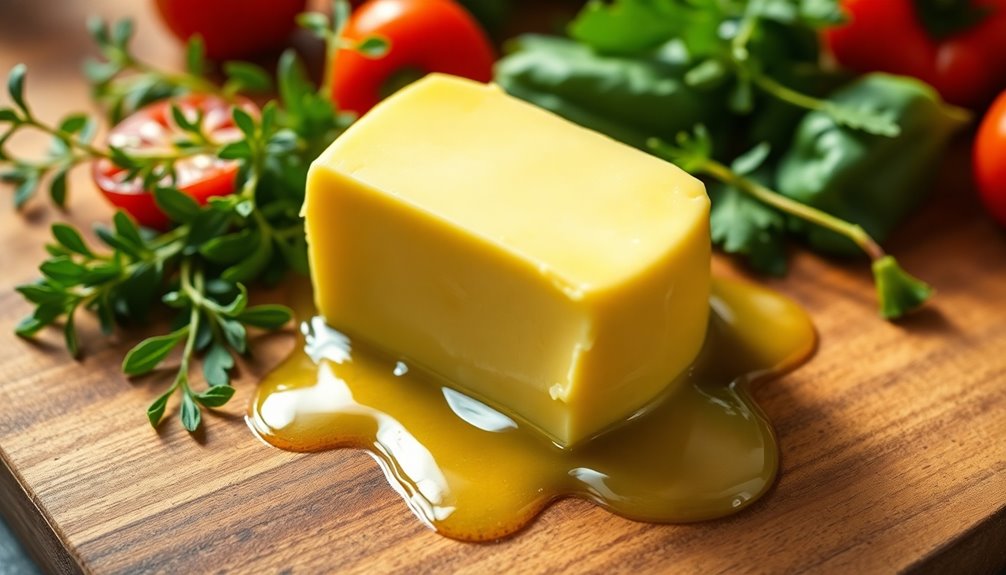
Butter boasts a rich nutritional profile that makes it a noteworthy addition to many diets. Each tablespoon packs 102 calories and 12 grams of total fat, including 7 grams of saturated fat, which provides energy and supports various bodily functions. You won't find any carbohydrates or fiber here, but it does offer a small amount of protein. Additionally, the dietary fiber found in foods like chia seeds can complement a diet that includes butter by promoting digestive health.
The fatty acid composition of butter is intriguing. It contains butyric acid, known for aiding digestion and reducing inflammation. Plus, you get a mix of other fatty acids like myristic, palmitic, and stearic acids, which can contribute to overall health. Butter is composed of about 80% milk fat, making it a highly concentrated source of fat. Additionally, butter contains essential fatty acids that are vital for maintaining overall health.
When it comes to vitamins and minerals, butter shines as well. A tablespoon provides 11% of your daily value of Vitamin A, along with small amounts of Vitamins E and K. Additionally, butter is rich in beta-carotene, which may lower the risks of certain cancers and help with age-related vision issues.
If you choose grass-fed butter, you'll also benefit from higher levels of fat-soluble vitamins.
Just remember, unsalted butter has about 2 mg of sodium, while salted can go up to 90 mg. Enjoy butter in moderation as part of a balanced diet!
The Case Against Regular Butter
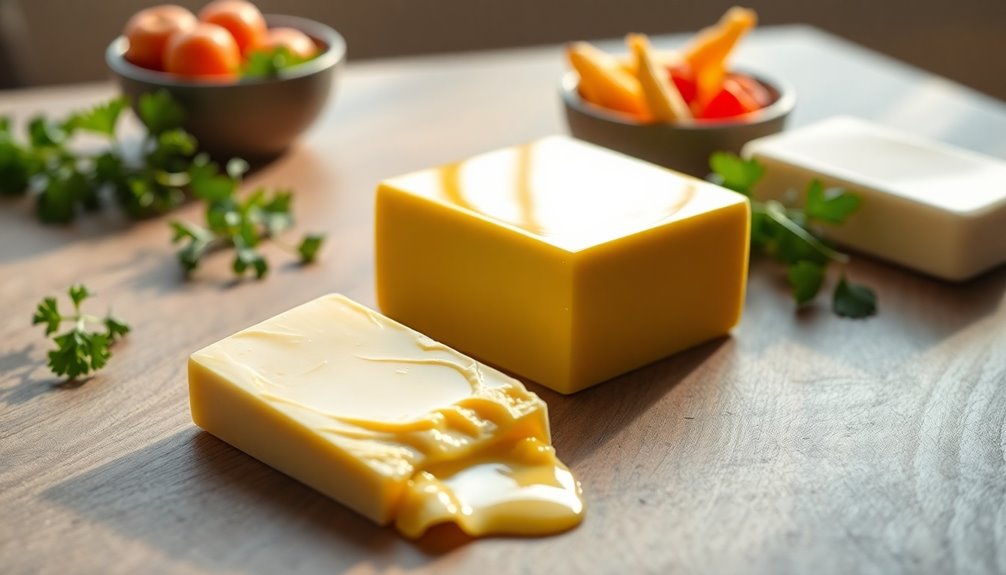
Regular butter poses several challenges for those following a Paleo diet. First and foremost, it's a dairy product, which our Paleolithic ancestors didn't consume. They didn't have access to milk or its byproducts until agriculture emerged, so butter simply isn't part of the caveman diet. Additionally, freshwater sucker fish are adapted to thrive in environments devoid of dairy, emphasizing the natural dietary preferences of various species.
Additionally, butter contains growth hormones and bioactive peptides designed for calves, not humans. This can lead to concerns about health risks, particularly for those who are sensitive to such compounds. Borderline Personality Disorder can also be exacerbated by dietary choices that affect mood and emotional stability. Furthermore, consuming products high in saturated fats can impact overall health and wellness.
Health risks associated with butter should give you pause, too. It's high in saturated and trans fats, both linked to heart disease. Eating butter can increase cholesterol levels and make weight loss more difficult due to its high calorie content. Furthermore, nutritional data suggests that excessive consumption of saturated fats may pose additional health risks.
For those with dairy allergies or lactose intolerance, butter's allergens can trigger unwanted reactions.
Furthermore, butter isn't lactose or casein-free, meaning it can contribute to digestive issues like leaky gut. The Paleo diet guidelines explicitly advise against all dairy products, including butter.
Even grass-fed butter doesn't meet the strict standards of Paleo. So, while you might love the taste, sticking to your Paleo principles means steering clear of regular butter and seeking alternatives that align with your dietary goals.
Benefits of Clarified Butter
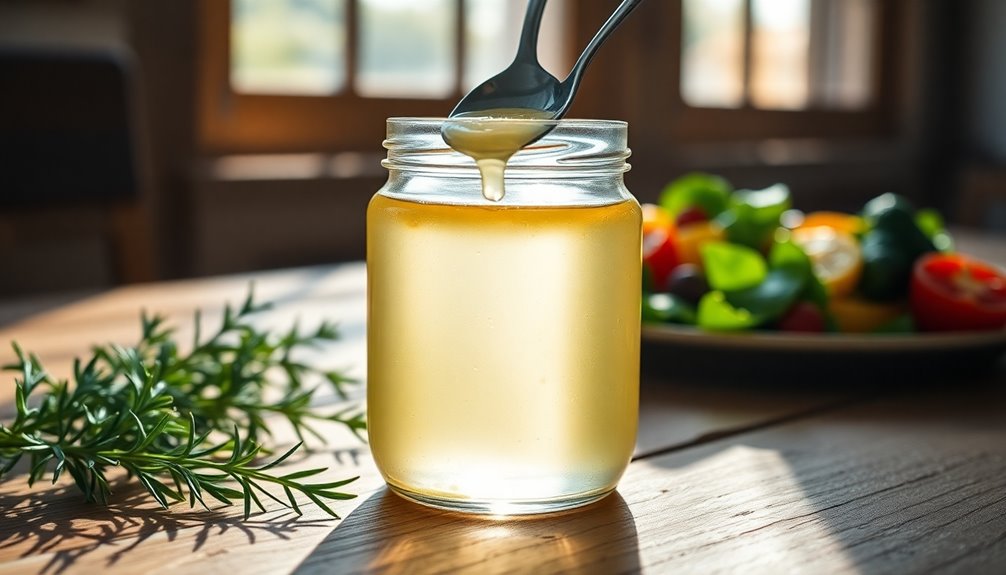
Clarified butter, often known as ghee, offers numerous health benefits that can complement a Paleo lifestyle. One of its standout features is its anti-inflammatory properties, thanks to butyrate, a fatty acid that helps reduce inflammation in your body. Additionally, ghee is known to enhance skin hydration and radiance, contributing to anti-aging benefits.
If you're focused on weight management, ghee's rich content of conjugated linoleic acid (CLA) may aid in fighting obesity and reducing body fat.
Your heart can also benefit from ghee, as it's high in monounsaturated omega-3s, supporting cardiovascular health. Plus, it enhances your body's ability to absorb essential vitamins and minerals from other foods. Additionally, ghee is free from lactose and casein, making it a suitable option for those with dairy sensitivities.
With no carbs or protein, ghee packs a high calorie density—857 calories per 100g—making it a potent energy source.
For your digestive health, ghee promotes a smoother digestion process by reducing acidity and bloating, while its butyrate content keeps colon cells healthy. Additionally, it's lactose and casein-free, making it suitable for those with dairy sensitivities.
Lastly, ghee supports skin and eye health, helping wounds heal faster and preventing dry eye syndrome. Incorporating ghee into your diet can bring a variety of health benefits while aligning with Paleo principles.
Ghee: A Paleo Alternative
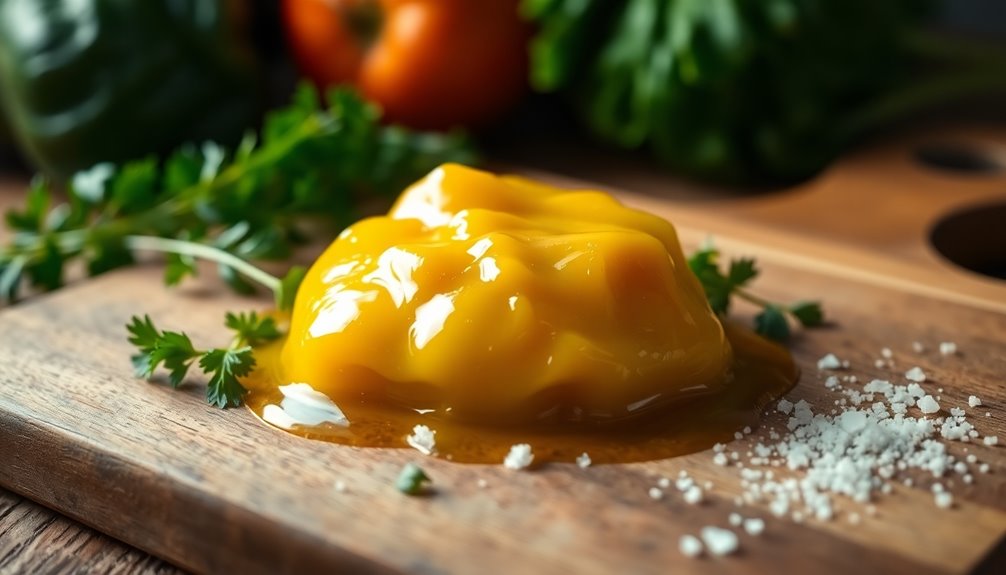
Ghee stands out as a fantastic option for those following a Paleo lifestyle. Derived from animal sources, it aligns perfectly with Paleo principles while being free from lactose and casein, making it a great dairy-free alternative. Its high smoke point makes it suitable for high-temperature cooking, so you can sauté, fry, or roast without worry.
With 130 calories and 15 grams of fat per tablespoon, ghee is rich in essential vitamins A, D, K, and E. It contains no carbohydrates, protein, or fiber, but its high levels of saturated and monounsaturated fats support heart health and may aid in weight loss through CLA. Ghee is also a source of healthy fats that contribute to overall well-being.
Additionally, ghee's butyrate content offers anti-inflammatory benefits and supports digestive health.
You can easily substitute ghee for other Paleo-friendly fats like lard or coconut oil in your cooking. Many Paleo recipes include ghee due to its nutritional benefits and ability to enhance the flavor of dishes.
Just remember to opt for high-quality, grass-fed ghee to maximize its health benefits and boost the nutritional value of your meals.
Moderation and Quality Matters
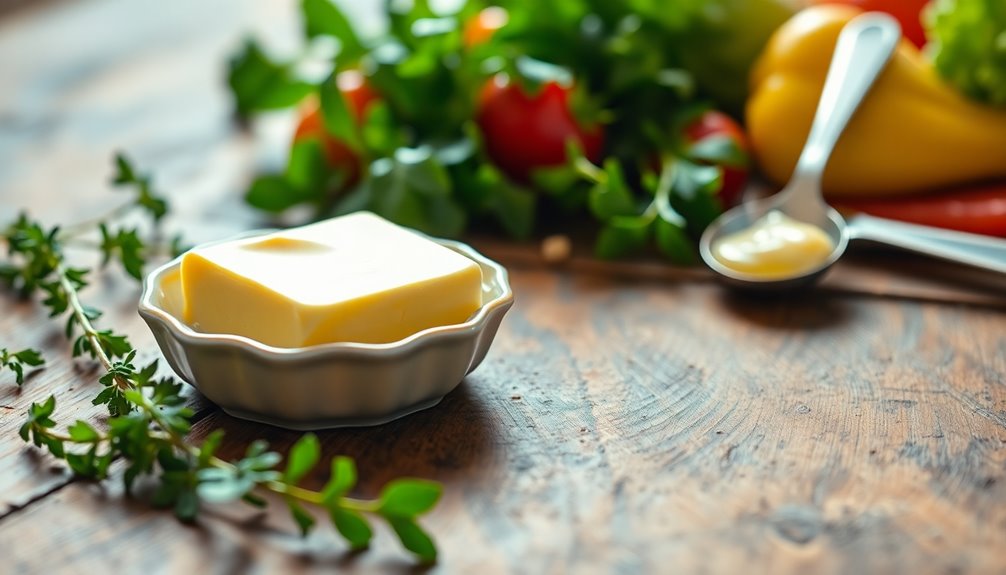
When it comes to incorporating butter into your Paleo diet, moderation and quality are essential. While butter is a dairy product often excluded from strict Paleo guidelines, many in the community make exceptions for high-quality, grass-fed butter. This type of butter boasts a better nutrient profile, rich in vital vitamins A, D, E, and K2, along with beneficial butyrate. These nutrients can enhance your health when consumed wisely. Additionally, it's crucial to remember that dairy products are largely excluded due to pre-agricultural diets, which influences the debates around butter's inclusion.
It's important to use butter as a flavor enhancer rather than a primary fat source. Opt for small amounts to sauté vegetables or finish dishes, ensuring that you maintain a balanced fat intake by including other healthy fats like olive or avocado oil. Overindulgence in butter can lead to an imbalanced diet, which is why moderation is key.
Choosing grass-fed butter not only supports your nutritional needs but also promotes sustainable farming practices. By prioritizing quality and being mindful of your portions, you can enjoy the health benefits of butter without compromising your Paleo lifestyle.
Practical Tips for Butter Use
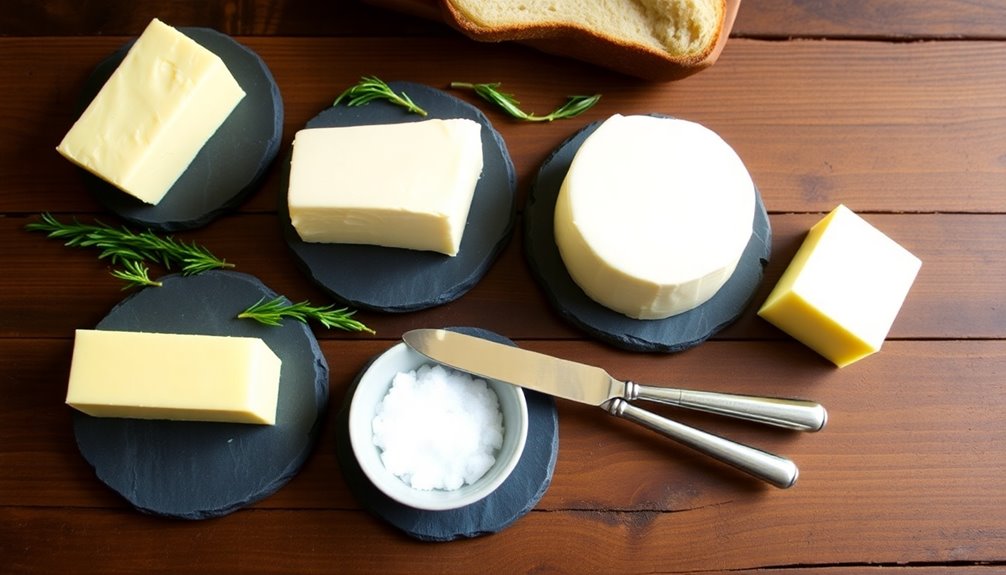
Often, incorporating butter into your meals can enhance flavors and boost nutrition when done thoughtfully. To reap the most benefits, choose grass-fed butter. It's richer in essential vitamins like A, K-2, and D, and contains conjugated linoleic acid (CLA), which may have cancer-preventing properties. Additionally, grass-fed butter is known for its high-quality fats, which contribute to a balanced diet. Essential oils can also be used in cooking to enhance flavor and provide health benefits. Butter is also a source of fat-soluble vitamins that are important for overall health.
Including nutrient-dense ingredients like chia seeds can further enhance your meals and support overall health. If you're lactose intolerant, consider using ghee, as it's free of lactose and casein. When cooking, use ghee for high-heat applications due to its high smoke point. For a nutritious energy boost, try adding butter to your bulletproof coffee or use it in baking and cooking as a healthy fat source.
Studies suggest that incorporating raw nutrition into your diet can also provide additional health benefits. Steer clear of margarine or butter-like products that contain hydrogenated oils or trans fats. While butter doesn't fit perfectly into strict Paleo principles, it can be included if you tolerate it well.
Focus on using high-quality, unprocessed options like grass-fed or clarified butter, which align better with your dietary goals. Remember to listen to your body—if you experience any allergic reactions or intolerance symptoms, it's best to avoid butter altogether.
Personalizing Your Paleo Approach
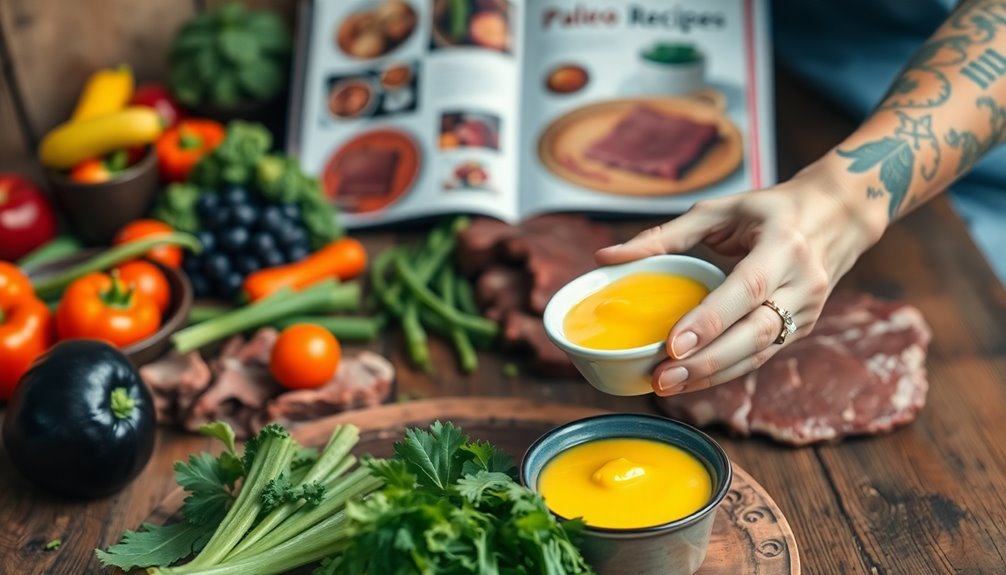
Finding the right balance in your Paleo diet can greatly enhance your health and well-being. Personalizing your food choices is key to achieving this balance. Start by experimenting with non-Paleo foods, such as dairy or white rice, to assess your body's tolerance. Adjust your macronutrient ratios—protein, fat, and carbohydrates—based on your individual needs. Incorporating proper preparation methods can also help enhance nutrient availability when introducing non-Paleo foods. Additionally, understanding macronutrient ratios can guide you in aligning your food choices with your health goals.
Remember, your dietary choices should evolve with the seasons and your life stages. Incorporate ancient preparation methods to help your body manage any non-Paleo foods you choose to include. Acknowledge your bioindividuality; everyone has different nutritional requirements and food tolerances.
Ensure your diet meets all nutritional needs by consuming a variety of whole foods. If you're dealing with specific health conditions, customize your plan accordingly. Your lifestyle habits, such as sleep and stress management, should also play a role in your overall dietary strategy.
Don't shy away from including grey-area foods like fermented options and high-quality packaged products, as long as they fit your framework. Aim for compliance with the Paleo diet about 80% of the time for long-term success, and empower yourself with knowledge about your unique health needs.
Frequently Asked Questions
Can I Use Butter for Cooking on the Paleo Diet?
You can use butter for cooking on the Paleo diet, but it really depends on your tolerance for dairy.
If you can handle it, opt for high-quality, grass-fed butter to enjoy its nutritional benefits. Just remember to use it in moderation and balance it with other healthy fats like olive or avocado oil.
If you're unsure, consider trying ghee, which is lactose-free and often a better fit for Paleo enthusiasts.
Is There a Paleo-Approved Butter Substitute?
If you're looking for a Paleo-approved butter substitute, consider options like coconut oil, ghee, or even avocado.
Coconut oil's rich flavor works well in both sweet and savory dishes, while ghee offers a buttery taste without the dairy proteins.
Avocado provides a creamy texture and is packed with healthy fats.
You can also create a homemade Paleo butter using coconut milk and olive oil for a customized option that fits your diet perfectly.
How Does Butter Affect Paleo Weight Loss Goals?
Butter can impact your Paleo weight loss goals significantly. While it offers nutritional benefits, its high calorie content may hinder your progress if you're not mindful.
If you choose to include butter, focus on portion control to maintain a caloric deficit. Alternatively, consider ghee, which is lactose-free and might be easier on your digestion.
Ultimately, balancing your intake is key to achieving your weight loss objectives while enjoying the flavors you love.
Can I Consume Butter if I'm Lactose Intolerant?
If you're lactose intolerant, you might be wondering if you can consume butter.
Generally, you can, since butter contains only trace amounts of lactose—much less than milk. Most people with lactose intolerance tolerate butter well.
However, if you're highly sensitive, you could experience symptoms. In that case, consider alternatives like ghee or lactose-free margarine.
Always listen to your body and consult a healthcare professional if you have concerns about dairy consumption.
Are There Any Paleo-Friendly Butter Recipes?
Absolutely, there are several delicious Paleo-friendly butter recipes you can try!
You can make a dairy-free butter using full-fat coconut milk, olive oil, and melted coconut oil. Blend the ingredients until creamy, then refrigerate until solid.
Another option is coconut butter, made from shredded coconut and coconut oil. Simply blend and store.
For a vegan alternative, whip softened coconut oil with nutritional yeast and salt.
Each option offers a great buttery taste without dairy!
Conclusion
In conclusion, whether you include butter in your Paleo diet really comes down to your personal preferences and health goals. If you choose to enjoy it, opt for high-quality, grass-fed varieties, and use it in moderation. Remember, everyone's body reacts differently, so listen to yours. Ultimately, the key is finding a balance that works for you while staying true to the principles of the Paleo lifestyle. Enjoy your journey to better health!
